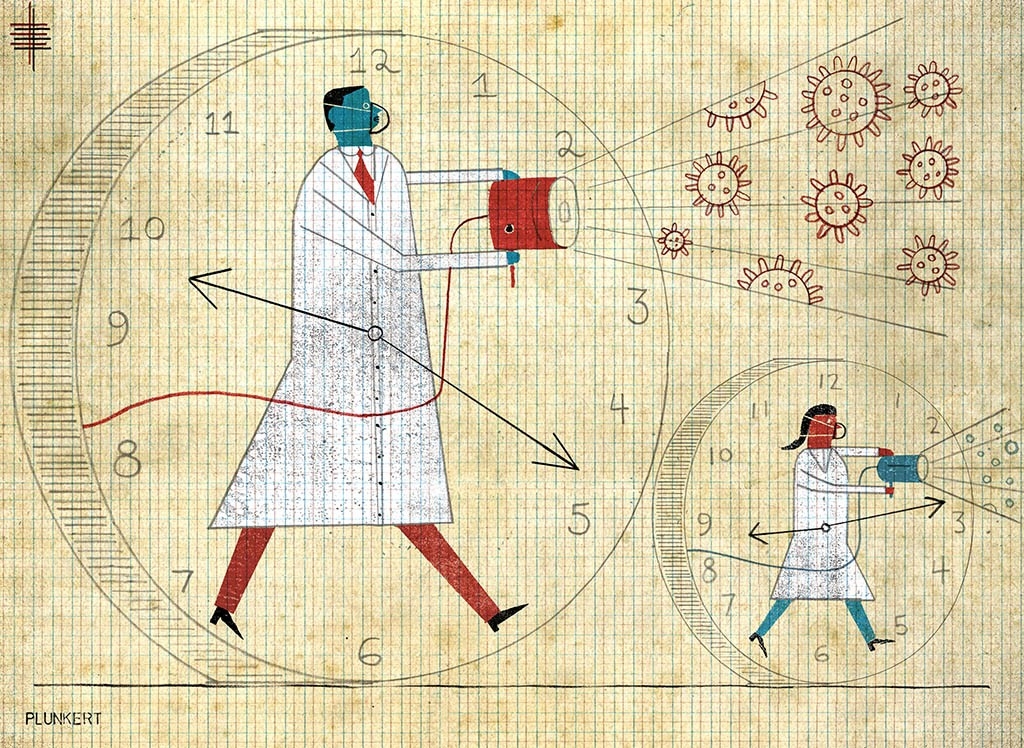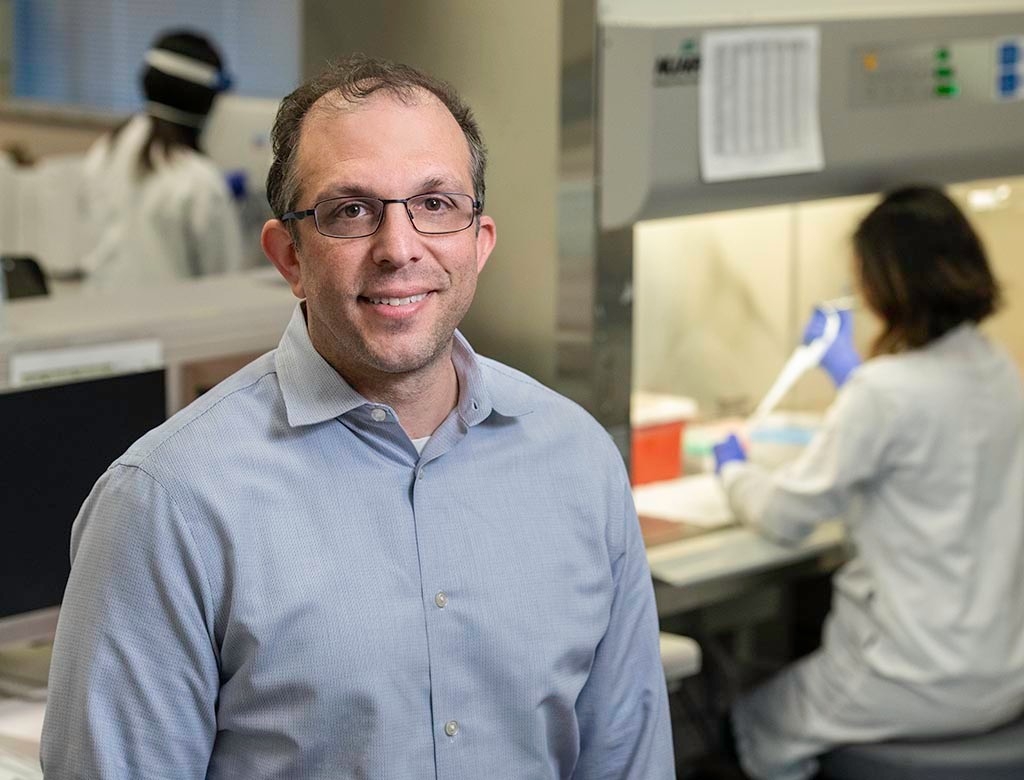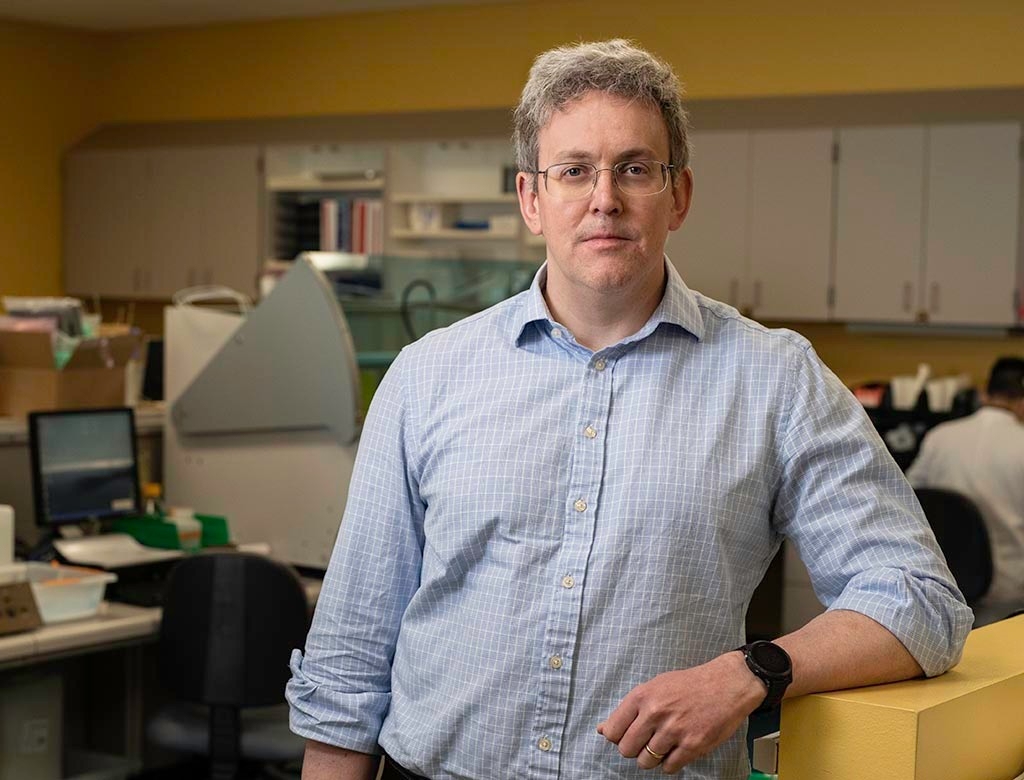Testing at the speed of COVID
Stanford launched its own test early in the pandemic — but the challenges kept on coming

It was Saturday morning, March 14, and infectious disease specialist Benjamin Pinsky, MD, PhD, was knocking on the locked entry door at the Beckman Center for Molecular and Genetic Medicine while simultaneously fielding a phone call. “Oh, there’s someone! I think they are going to open the doors for me.”
Pinsky, an associate professor of pathology and the medical director of Stanford’s Clinical Virology Laboratory, needed access to the Protein and Nucleic Acid Facility in the building’s basement to collect short stretches of DNA called primers — a critical component of a test Pinsky and his colleagues devised to detect the presence in patients of the genetic material of the deadly coronavirus that was sweeping the globe.
Pinsky launched the test on March 4, shortly after the Food and Drug Administration allowed some qualified laboratories to use coronavirus tests that were developed and validated in-house.
Stanford’s test was among the first in the nation developed at an academic medical center and the lab quickly became the testing epicenter in Northern California in the early days of the pandemic.
But the development of the test to detect active infection — known as an RT-PCR test — was just the beginning of many challenges. During the next weeks, researchers tackled problems of scarce resources, regulatory hurdles and an increasing demand for tests that could also identify people who had recovered.
The researchers’ efforts would help uncover how the new virus spreads, who was at risk and how the body responds to infection. The researchers would also explore whether an infected person could become immune to the virus, and, if so, for how long.
This combination of test development and scientific study in the early days of the pandemic meant that Stanford Medicine became an invaluable resource for public policymakers scrambling to protect California citizens from the virus.
“The rapid implementation of the tests developed at Stanford allowed us to better understand the evolution of the pandemic in the Bay Area and California,” Pinsky said. “It informed our governor and other decision-makers as they established our first shelter-in-place orders, and it limited the initial spread of the infection in the Bay Area.”
But, in early March, the primary concern was how to treat patients who were starting to show up at the hospital with symptoms that raised suspicions of COVID-19 but had no clear diagnosis. And access to testing was scarce across the country.
“The Food and Drug Administration had only authorized the test offered through the Centers for Disease Control, which was in very limited supply,” recalled Christina Kong, MD, professor of pathology and medical director of pathology and clinical lab services at Stanford Health Care.

Pinsky and his colleagues had been tracking the novel virus in the weeks before it arrived in California. They began working on the PCR diagnostic test in mid-January after a laboratory at the Charité Hospital in Berlin published their PCR method and primer sequences.
Pinsky’s laboratory optimized the test in late January and began using it to screen clinical samples from Stanford patients presenting with respiratory illness in February.
“We wanted to know whether the virus, which had been detected in Washington state in late January, was already circulating undetected in the Bay Area,” said James Zehnder, MD, professor of pathology and director of clinical pathology at Stanford Health Care. “In late February, we got our first positive samples. It was clear the virus was here.”
The Stanford researchers were prepared.
“One of the first things that occurred early in my clinical pathology training was the H1N1 flu pandemic in 2009,” Pinsky said. “I knew the possibility of a pandemic was part of this sort of a career, and I’ve monitored several around the world since then. Of course, most of the outbreaks over the past 10 years haven’t significantly impacted the United States, so this was different.”
Becoming a coronavirus-testing
resource for the Bay Area
Kong was out of town when Pinsky applied for the FDA authorization for their coronavirus test on March 2. When she returned on Friday, March 6, she discussed the test with Zehnder, who suggested that Stanford offer to test patients from other Bay Area facilities that also had possibly infected patients.
“All the hospitals were in the same bind,” Kong said. “So we worked through the night to set up a website and a requisition form, and by midday Saturday I was able to contact UCSF and tell them they could start sending us samples.”
Calls were soon flowing in from institutions across the country, so researchers had to prioritize. They decided to limit early testing to hospitalized patients in the greater Bay Area who, if positive, would need to be cared for by physicians in personal protective equipment, or PPE.
“We knew PPE was getting to be in short supply, so it would be important to only use it when necessary,” Kong said. “We also decided to test only those samples that could be delivered to us by car to limit delays due to transport time.”
By March 14, 10 days after the testing was launched, the number of tests completed per day grew to nearly 1,000. But obtaining the test’s necessary components — from the DNA primers to the liquid used to transport biological samples to the Stanford lab — from commercial sources quickly became nearly impossible.
“There were massive supply chain failures at all steps, any one of which would have shut our testing down dead in the water,” Zehnder recalled.
“But this is when being at a place like Stanford is really great. We realized we could make the primers here at Stanford. So we contacted Ian Anderson at the PAN [Protein and Nucleic Acid] facility, and Ian stayed up all night and had them ready for Ben to pick up the next morning.”
The researchers also partnered with a local 3D-printing company and Ryan van Wert, MD, a clinical assistant professor of medicine and the assistant director of the Stanford Biodesign Faculty Fellowship, to ensure a stable supply of the swabs needed to collect samples for testing.
“It was incredible to see people from all areas come together and make this happen,” Zehnder said.
During the next few weeks and months, the laboratory continued to increase daily capacity from 1,000, to 2,000, to nearly 5,000 tests. They also rolled out in-car, drive-through testing, at first in the parking garage next to Stanford’s emergency department and then at locations around the Bay Area. In collaboration with the occupational health department, they also began to test thousands of Stanford Health Care and Stanford Children’s Health employees who routinely interact with patients.
Pinsky stopped going home to San Francisco at night and stayed at a hotel near campus to avoid any downtime during a commute that had become complicated.
“People kept calling me and I’d have to pull off the road to answer their questions and look up the data they needed,” he recalled wryly. “It wasn’t the safest situation.”

The science of figuring out
who’s already had COVID-19
Pathologist and immunologist Scott Boyd, MD, PhD, had also been eyeing the developing situation in China early in the pandemic. Boyd specializes in studying how the human immune system responds to viral infection and allergies. He’s particularly interested in the role of antibodies — the protective molecules generated by immune cells called B cells. And he was worried.
It was becoming clear that Stanford should develop another critically important test designed not to detect an active infection, but a past infection of the new coronavirus. Called a serology test, it looks for the presence of antibodies against the virus in the blood of seemingly healthy people.
Learning how many people may have already been infected is an important step in understanding the evolution of the pandemic in California and whether a past infection can protect against, or decrease the severity of, a subsequent infection. It may also help researchers and physicians understand why some infected people become very ill and die and others exhibit few if any symptoms, as well as how long an infected person might be contagious.
Boyd began talking to Taia Wang, MD, PhD, an infectious disease expert and assistant professor of microbiology and immunology, and Peter Kim, PhD, the Virginia and D.K. Ludwig Professor of Biochemistry. Wang and Boyd brainstormed about how to develop the serology test, which uses a technique called an enzyme-linked immunosorbent assay, or ELISA, while Abigail Powell, PhD, a postdoctoral scholar in Kim’s laboratory, generated fragments of the virus’s “spike” protein, which enables the virus to bind to human cells and enter them.
Boyd and his colleagues, including postdoctoral scholar Katharina Roeltgen, PhD, then used the protein to develop, test and implement a serology assay in Stanford’s Anatomic Pathology and Clinical Laboratories that can detect the presence of two types of antibodies — IgG and IgM — that recognize and bind to the receptor binding domain on the spike protein.
“During the last two weeks of March, Katharina and I were working 16-hour days,” Boyd said. “Each round of experiments takes four or five hours, and then we’d tweak some conditions and try again. It was a period of intense work. But we were up and running with the test in the clinic by April 7.”
Initially, the test was primarily used for Stanford patients but it was soon also used for Stanford Health Care and Stanford Children’s Health employees.
Although other commercially available serology tests have struggled to provide the sensitivity and specificity necessary to deliver reliable results, the Stanford test succeeded, delivering about one false positive in every 500 tests, and detecting antibodies in 97% of patients with confirmed infection three weeks after the onset of symptoms.
“Despite the pressure, the idea of not delivering the tools our physicians and researchers needed to care for our patients and employees never came up,” Zehnder said. “There has been a sense of, ‘This is what we were trained to do, and we will make it happen.’ It is a good feeling to be part of an organization that responds so well to this type of challenge.”
Puzzling out the specifics
of immunity
Now Boyd and his colleagues are trying to learn what it all means. Does the presence of antibodies protect against subsequent infection? Recent research in non-human primates implies it does. But if so, how long do the antibodies and the protection last? How can we use what we’ve learned to develop the best, longest-lasting vaccines? And how do we respond to other pandemics likely to arise in the next years or decades?
“In many ways, the very earliest days of the pandemic were an exercise in denial,” Boyd said. “I had been following the start of the outbreak in China since December; I had all the facts available to me. But even then I had no idea that this would become such a major research topic in my laboratory for what will probably be the next two years or more.”
Recently, Boyd, Pinsky and their colleagues found that, intriguingly, the very sickest COVID-19 patients also make the highest levels of antibodies against the spike protein, while patients who are mildly ill make only modest amounts. In patients with mild illness, the antibodies don’t seem to last long — dwindling over a period of just a few weeks. The news is preliminary, but suggestive. A similar pattern of antibody expression is seen with other, non-lethal coronaviruses. And the outcome may not be as dire as the news first seems.
“Of course, not having antibodies in the blood doesn’t necessarily mean that previously infected people are no longer immune,” Roeltgen said. “We can’t say that, because we don’t know. We might have memory responses in immune cells like T cells that could be protective against a subsequent infection by the virus.”
Many more studies of all types are underway, including whether patient samples could be collected in less invasive ways than the long nasopharyngeal swab commonly used now. Researchers are studying whether people can collect their own samples, eliminating the need to travel to a health care facility and conserving PPE for health care workers.
Also, as of July 22, the Stanford clinical virology laboratory learned from the FDA that they can begin pooling samples from multiple testing subjects pending a final review by the agency. This will enable conservation of test resources and streamline routine testing. The method is likely to be critical for quickly identifying and suppressing outbreaks in communal living situations, including skilled nursing facilities, college dormitories and jails.
Meanwhile, researchers in Boyd’s laboratory and other Stanford labs are investigating whether long-term protection from the virus occurs after infection or vaccination and if so, how long it lasts. They’ve set up blocking assays to determine whether the antibodies detected by the serology assay are able to prevent the spike protein from binding to the human receptor protein, ACE2, or otherwise prevent the virus from infecting cells.
“Our tests, as well as others in non-human primates exposed to the virus, give some good experimental evidence to the idea that previously infected people will probably have at least some, possibly temporary, level of protection,” Boyd said. “Of course, the important thing will be to learn which antibody test results best correlate with the real protection of an actual person exposed to the virus in their environment, and then whether we can induce those antibody responses through vaccination.”
Answers to these questions are urgently needed as the number of cases in the Bay Area and across the country continue to rise and test components become scarce.
“It feels like we’re running in front of a huge tidal wave, trying to keep one step ahead,” Kong said. “You’re always short something you never would have imagined. Right now, it’s pipette tips. But I’m confident we can handle this. COVID-19 is going to be with us for a while, and we’ve realized that we have to pace ourselves.”

